Unique jewellery, made the way you want it.
Gemstone Zone
Gemstones are minerals, rocks, or other organic materials that have lustre or other physical properties that give them an aesthetic value. When cut, shaped and polished, they are often used to make jewellery. Many have impurities that can lead to colour variations, even within the same gemstone. Many people also believe that gemstones have healing properties. To find out more about the healing aspect of individual gemstones, I highly recommend visiting the He Hi She Lo website. Thank you to Steve from He Hi She Lo for allowing us to use these beautiful gemstone pictures for this information page.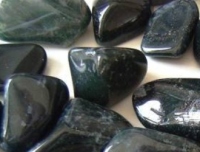
Agate is the birthstone for June. It has been used for various purposes throughout the ages. A Greek philosopher discovered it on the shore of the river Achates, and he gave it its name. Most agates (of which there are many different types) form in volcanic rocks and have colour variations within the same stone. Banded agate is formed in successive layers to give its attractive stripes. Moss agate (pictured) has green colours similar to that of its namesake. Dendritic agates have fern-like designs throughout their structure, due to the presence of oxides. Fire agate originates in California and is typically found in colours associated with fire. Blue Lace agate has a delicate sky blue colour caused by dolomite combined with a beautiful banding effect. Agate continues to be popular today and always in demand due to the fact that practically every stone is different and unique.
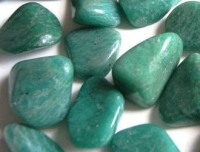
Amazonite takes its name from the Amazon River where it was once obtained, but it is thought that does not occur naturally in the Amazon area. One of the features of the stone’s crystal structure is a lustrous reflection from planes in a mineral grain, similar to what is more commonly known as iridescence. It has a pretty bright blue-green colour when polished, hence its popularity in jewellery.
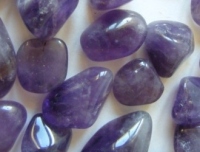
Amethyst is a purple variety of quartz, and is traditionally the birthstone for February. The ancient Greeks and Romans believed that the stone protected the owner from becoming drunk, and indeed the name is derived from the Greek word for intoxicated. Medieval European soldiers wore amethyst amulets in battle as they believed it could heal people.
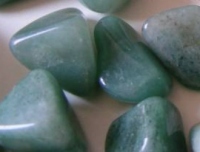
Aventurine is a form of quartz, and interestingly is derived from the Italian a ventura meaning by chance. This is due to the accidental discovery of aventurine glass (a type of glass that sparkles) in the 18th century. Aventurine can be found in various colours, but the most common is a medium green. Besides its uses in jewellery, aventurine is also used for ornamental purposes (for example figurines, bowls and vases).

Black Onyx is a variety of the microcrystalline quartz called chalcedony. Onyx was used widely in the past as bases and handles for gold items, as well as for stone inlay work. Onyx seals were very popular with the Romans, who carved the pattern of the seal in negative relief to give a raised point. Onyx is the Greek word for "claw" or "fingernail", because the fleshstone variety resembles a fingernail. Along with diamond, black onyx is often the gemstone given to celebrate the 10th year of marriage.
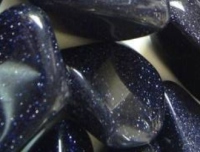
Blue Goldstone is a variety of goldstone, which is thought to have been an accidental discovery by Italian monks or alchemists. Its glittery appearance leads it to be often mistaken for a natural mineral, and make it a popular choice for jewellery. The blue form of goldstone contains tiny cobalt crystals that have a more silvery appearance than the more common reddish-brown goldstone.

Carnelian is a variety of chalcedony coloured reddish brown by iron oxide impurities. Its name is thought to be derived from a type of cherry known as the cornel cherry, as this gemstone resembles the translucent red fruit. The colour can range from pale orange to very dark red. Carnelian was once considered strictly the property of the noble class, and people with a high social status were often buried with this gemstone.
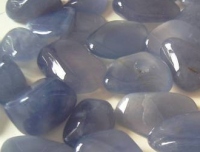
Chalcedony is a form of translucent quartz in which the crystals are too small to be seen without high magnification. Blue chalcedony has a waxy appearance, varies in colour from pale to medium tones and also has varying degrees of translucency. The Native Red Indians considered it a sacred stone, as they believed it promoted brotherhood. Chalcedony is a tough gem, which makes it good for all jewellery applications.
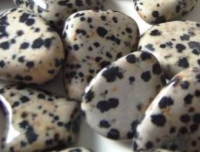
Dalmatian jasper acquired its name due to the similarity of spotted markings with Dalmatian dogs (the reason is fairly obvious once you see a picture of it). Jasper is an opaque variety of the mineral quartz, and a member of the chalcedony family. It often contains organic material and iron oxides that account for its interesting patterns, bands, and colours (such as these gorgeous spots). When polished, jasper takes a beautiful shine. Since Dalmatian jasper contains neutral colours (black and white), it is a popular choice for jewellery because it will compliment almost any outfit.
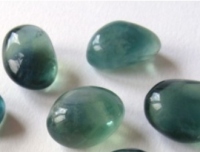
Fluorite derives its name from the Latin fluor meaning to flow because it is so useful as a flux (i.e. helping metals to flow more easily during the smelting process). In 1852 fluorite gave its name to the phenomenon known as fluorescence (which is when an item appears to be glowing when placed in ultra-violet light). This glowing is thought to be due to mineral impurities. Fluorite has often been referred to as “the most colourful mineral in the world,” due to the variety of colours it can be found in. The most common colours are purple, blue, green and yellow, and more than one colour can often be seen in a single stone.
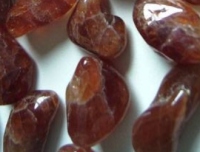
Garnet is traditionally the birthstone for January, and is usually a saturated dark red colour. Garnet has been used for thousands of years. It has been recorded that Noah used garnet to safely steer the Ark through the darkness of the night, and ancient jewellery from various cultures has been found with garnet. It was also used as a protective stone to ward away evil spirits.

Goldstone, also known as aventurine glass or monk’s gold, is thought to have been an accidental discovery by Italian monks or alchemists. Its glittery appearance leads it to be often mistaken for a natural mineral, and make it a popular choice for jewellery. The most common form of goldstone is reddish brown and contains tiny copper crystals that need special conditions to form properly.
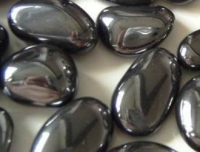
Hematite is a silvery, shiny opaque gemstone that almost looks like metal. The name comes from the Greek word for blood. In ancient times this gemstone was used by Egyptians to aid the flow of blood in the body, and was often worn as a talisman in case of excessive bleeding. Ancient myth subscribes to the notion that large deposits of Hematite were formed wherever battles were fought and wherever blood flowed as a result of those battles. Hematite is a distinctive gemstone that complements almost all silver or gold based jewellery.
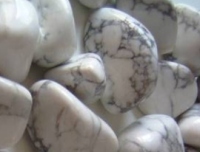
Howlite was named after the person who discovered it, Henry How, during the 19th century. Howlite has an earthy lustre and is generally white or grey with spidery veining forming erratic patterns. In its natural state it imitates the shape of the head of a cauliflower.
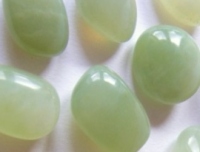
Jade is derived from the Spanish term piedra de ijajda meaning “loin stone,” as it was thought to help ailments of the loins and kidneys. Simple ornaments made from jade have been excavated from prehistoric sites. In China, jade was known as yu, the “royal gem.” Skilled artisans created works of art from it for the Chinese Imperial court, as jade had a status-value exceeding that of gold. Other cultures have also held this gemstone in high esteem, but even to this day nowhere more so than Asia.
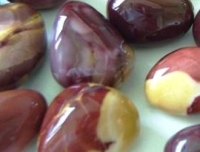
Mookaite, or Mook Jasper, is an Australian jasper that combines yellow, brown and red jasper. It is formed as a sediment in erosion zones and a filler in cracks. It is named after the place it was first found – a sheep farm called Mooka Station. Occasionally a mookaite stone will have conspicuous black dendrite trees running through it that will add to its value.

Quartz is the most common mineral found on the surface of the Earth. It has always been a popular mineral for making jewellery and carvings, and has an impressive range of varieties and colours. In its natural state the crystal is angular in shape, always with six sides, tapering at the end to a point. Quartz is very versatile and its uses extend far beyond making jewellery. It is typically used for making kitchen countertops, in the glass making process, for sharpening razors and knives, as well as being components of wristwatches and other electronic devices.
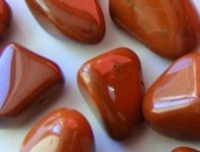
Red Jasper is a red patterned gemstone found worldwide, which owes its reddish colour (and name) to iron inclusions found in jasper. Jasper itself is an opaque variety of the mineral quartz, and a member of the chalcedony family. It often contains organic material and oxides that account for its interesting patterns, bands, and colours. When polished, jasper takes a beautiful shine. The bold red colour stands out nicely against either gold or silver jewellery, and it also sits well with black agate.
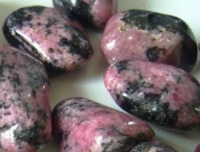
Rhodonite is an attractive rose-red gemstone that has acquired its name from the Greek word rhodon, meaning “rose.” Rhodonite often has black manganese oxide veins running through a specimen, giving it the distinct appearance of pink with black criss-crossing lines and flower-like formations throughout. The Romans used to carry rhodonite with them on their travels, as it was believed to increase the heart rate of a traveller if danger was approaching.

Rose Quartz is one of the most desirable types of quartz. It has a distinct pale pink to rose red hue, which is unlike any other pink mineral species. The colour is due to tiny amounts of titanium, iron or manganese embedded in the structure. Rose quartz is usually found with relatively large crystals.
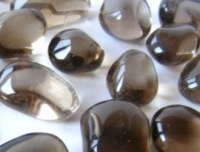
Smoky Quartz ranges in clarity from almost complete transparency to a brownish-grey crystal that is almost opaque. Its unusual colour makes it popular and easily recognised. Cairngorm is a well-known variety of smoky quartz that comes from the Cairngorm mountains in Scotland, and morion is a dark opaque type of smoky quartz. It is thought that the unusual colour is due to the amount of radiation exposure of the minerals.
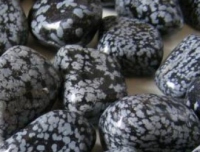
Snowflake obsidian is a shiny black volcanic stone with distinctive grey and white patterns. The markings (or “spherulites”) resemble snowflakes, so it’s not hard to see how it got the first part of its name. Obsidian is the rock formed as magma from a volcano is cooled rapidly, similar to the process of making glass, and when this substance starts to lose the characteristics of a glass, the grey-white spots of snowflake obsidian become visible. Snowflake obsidian has often been used to perform an old method of finding lost items, known as scrying. It has a beautiful shine when polished, which makes it a popular choice for jewellery.

Sodalite is a royal blue mineral, and is named after its sodium content. It is often distinguished by its white calcite streaks interspersed through it. Sodalite is sometimes called “Princess Blue,” the origin of which is thought to stem from Princess Patricia, the granddaughter of Queen Victoria. It is said that Princess Patricia of Connaught so loved this stone after seeing it in a visit to Ontario, that she chose it for decorating the Marlborough House in England.
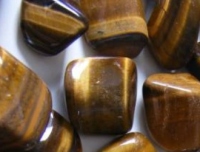
Tiger’s Eye is an unusual member of the quartz family that typically includes shades of honey, yellows, oranges and browns. The patterns it forms, its unusual colours, the way it reflects the light and its silky lustre, all very much resemble the elements of a tiger’s eye. Each stone will display different colours according the exact nature and amount of the inclusions. The stone is sometimes associated with a ninth wedding anniversary.
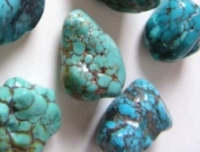
Turquoise is derived from an old French word for “Turkish,” because it was first brought to Europe from Turkey. The colour of this opaque mineral is highly variable, ranging from white to sky blue, and from blue-green to yellow-green. Its pastel shades and waxy lustre have proven popular throughout the centuries. It is typically seen with flecks of pyrite or spidery limonite veining. A common belief held by ancient civilisations was that turquoise was thought to change colour with the wearer’s health. It is the birthstone for December.